
Kershaw County is a county located in the U.S. state of South Carolina. As of the 2020 census, its population was 65,403. The county seat and largest city is Camden. The county was created in 1791 from parts of Claremont, Lancaster, Fairfield, and Richland counties. It is named for Col. Joseph Kershaw (1727–1791), an early settler and American Revolutionary War patriot.

Kershaw is a town in Lancaster County, South Carolina, United States. It was incorporated in 1888. As of the 2010 census, the population was 1,803, and as of 2019 the estimated population was 2,321. The Haile Gold Mine, where gold was discovered in 1825, is 3 miles (5 km) from town and was at one time the largest single producer of gold in the Appalachian region.

The city of Lancaster is the county seat of Lancaster County, South Carolina, United States, located in the Charlotte Metropolitan Area. As of the United States Census of 2010, the city population was 8,526. The city was named after the famous House of Lancaster.

Robert Mills was a South Carolina architect known for designing both the first Washington Monument, located in Baltimore, Maryland, as well as the better known monument to the first president in the nation's capital, Washington, DC. He is sometimes said to be the first native-born American to be professionally trained as an architect. Charles Bulfinch of Boston perhaps has a clearer claim to this honor.

Bethesda Presbyterian Church is a historic church at 502 DeKalb Street in Camden, South Carolina. A National Historic Landmark, the main church building was built in 1822 and is one of few surviving churches designed by 19th-century American architect Robert Mills.

Lancaster County Courthouse is a historic courthouse in Lancaster, South Carolina. Built in 1828, it has been in continuous use since then. It was designated a National Historic Landmark in 1973, as a possible work of Robert Mills, an important American architect of the first half of the 19th century. It also has the distinction of being the site of the last witch trials to take place in the United States.
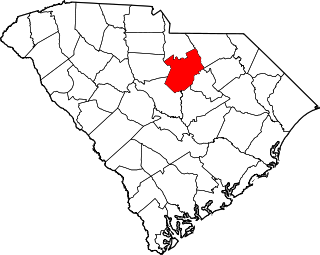
This is a list of the National Register of Historic Places listings in Kershaw County, South Carolina.
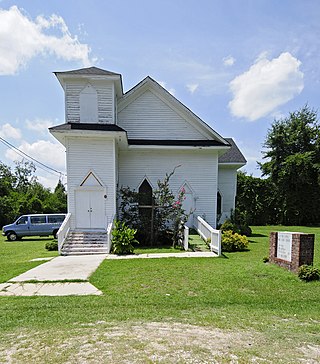
Clinton AME Zion Church is a historic African Methodist Episcopal church located on Johnson Street between Marion and Richland Streets in Kershaw, Lancaster County, South Carolina. It was built in 1909, and is a one-story, T-shaped, Gothic Revival style frame structure covered with clapboard siding and has a brick pier foundation with concrete block infill. It was the first separate black church established in Kershaw in the early 20th century.

Unity Baptist Church is a historic African American Baptist church at Sumter and Hart Streets in Kershaw, Lancaster County, South Carolina. It was built in 1910, and is a Late Gothic Revival style frame church building. Also on the property are the contributing church's parsonage and its privy.

Cool Springs is a historic home located near Camden, Kershaw County, South Carolina. It was built about 1832, and is a two-story Greek Revival style house on a raise brick basement. The original house was remodeled in the 1850s. It features a tiered portico and verandahs, supported by 64 Doric order columns. A two-story kitchen addition was attached to the house about 1935. Also on the property are the contributing two horse stables, a concrete piscatory, an old stone spring, a brick basin, a dam, and granite gate posts.
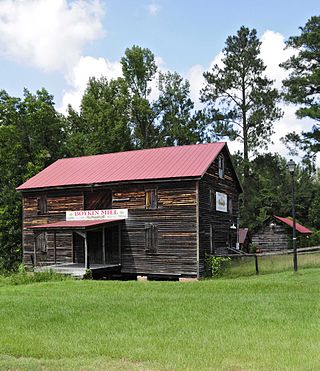
Boykin Mill Complex, also known as Mill Tract Plantation, is a national historic district located near Camden, Kershaw County, South Carolina. The district encompasses nine contributing buildings, two contributing sites, and four contributing structures. “Boykin Mill” denotes a community which consists of an old post office, an old general store, a c. 1905 grist mill, mill pond, mill dam, gates, and canals. The community also includes an early 19th-century Greek Revival style Baptist church, one mid-19th-century residence, three 20th-century residences built for mill workers, and a smoke house. An American Civil War battle site is also a part of the Boykin Mill community. The Battle of Boykin's Mill took place on April 17, 1865.

City of Camden Historic District is a national historic district located at Camden, Kershaw County, South Carolina. The district encompasses 48 contributing buildings, 8 contributing sites, 2 contributing structures, and 3 contributing objects in Camden. The district is mostly residential but also include public buildings, a church, and a cemetery. Camden's architecture is classically inspired and includes examples of Federal, Greek Revival, and Classical Revival, in addition to cottage-type, Georgian, Charleston-type with modifications, and mansion-type houses. Several of the city's buildings were designed by architect Robert Mills. Notable buildings include the Kershaw County Courthouse (1826), U.S. Post Office, Camden Opera House and Clock Tower, Camden Powder Magazine, Trinity United Methodist Church, St. Mary's Catholic Church, Gov. Fletcher House, Greenleaf Villa, The First National Bank of Camden, and the separately listed Bethesda Presbyterian Church and Kendall Mill.

Kendall Mill Historic District is a historic mill complex, mill village, and national historic district located at Camden, Kershaw County, South Carolina. The district encompasses 119 contributing buildings, 1 contributing sites, and 1 contributing structure in Camden. The district is centered on the Wateree Plant and associated structures that date from 1899 to 1923. The mill village to the south and southeast of the plant was built between 1900 and ca. 1925 and is a virtually intact reminder of the importance of the textile industry to South Carolina. The mill faces Kendall Park, a ten-acre landscaped park. On the eastern border of the park are the mill supervisors’ houses, built between 1900 and ca. 1925. The operatives house consist of one-story, 1 1/2-story, and a few two-story frame houses which date from 1900 to 1923. The district also includes Kendall Lake, north of the mill. The Dekalb Cotton Mill was organized in 1899. The Dekalb Mill building, designed by W.B. Smith Whaley in the Romanesque Revival style, was considered a model of textile architecture. The original plant building is a four-story rectangular brick building with a back stair tower and an imposing six-story front stair tower. The west addition to the plant, which is in keeping, architecturally, with the older buildings, was constructed in 1964. It is located in the City of Camden Historic District.
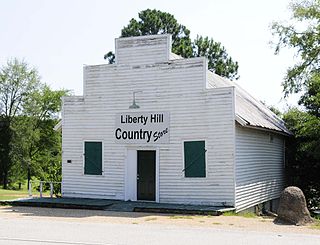
Liberty Hill Historic District is a national historic district located at Liberty Hill, Kershaw County, South Carolina. The district encompasses 34 contributing buildings and 2 contributing structures in the small rural community of Liberty Hill. The district includes several imposing Greek Revival structures, Greek Revival cottages, and an 1880s vernacular Gothic Revival church. The later, turn of the 20th century residences are primarily one-story, simple clapboard cottages. The town's history begins as early as ca. 1813 when Peter Garlick's store was a gathering place for surrounding farmers. Soon, impressive structures were built by planters in the area. Remaining from the 1830s are Cool Spring and the Joseph Cunningham House. The majority of the town's antebellum buildings, however, were built ca. 1840–1850. During this period Liberty Hill was a very wealthy community. However, the final days of the American Civil War ended that prosperity. Nevertheless, the town did eventually reassert itself and appears to have changed very little since the beginning of the 20th century.
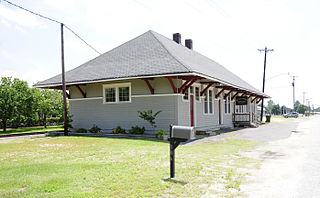
Kershaw Depot, also known as the Southern Railway Depot, is a historic train station located at Kershaw, Lancaster County, South Carolina. It was built in 1926, by the Southern Railway, and is the second or third depot built in Kershaw. The interior plan consists of a central ticketing area flanked by white and "colored" waiting areas. The Southern Railway sold the depot in 1945, and it has since been used as a florist and craft shop.

East Richland Street-East Church Street Historic District is a national historic district located at Kershaw, Lancaster County, South Carolina. It encompasses 28 contributing buildings in a residential section of Kershaw. The majority of the residences date from about 1890 to 1920, a particularly significant period of development in Kershaw. The houses are in a variety of representative architectural styles include Victorian, Queen Anne, Colonial Revival, and Neo-Classical.
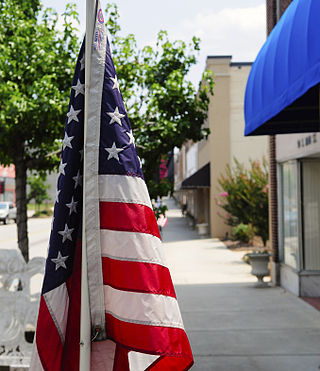
Lancaster Downtown Historic District is a national historic district located at Lancaster, Lancaster County, South Carolina. It encompasses 12 contributing commercial buildings in central business district of Lancaster. The buildings date from about 1880 to 1935. It is the most intact section of Lancaster's early business area. Notable building include the United States Post Office, the Springs Block, the Farmers’ Bank and Trust Company Building, and the Bank of Lancaster/Opera House.

Lancaster Cotton Oil Company is a historic factory complex and national historic district located at Lancaster, Lancaster County, South Carolina. It encompasses five contributing buildings and six contributing structures associated with the Lancaster Cotton Oil Company established in 1907. The Lancaster Cotton Oil Company office and seed house burned in 1913 and were replaced as the company continued to grow. After the post-World War I decline the Lancaster and Kershaw cotton oil mills were among South Carolina's larger and more centrally located mills which survived into the 1930s and 1940s. Contributing resources include the Seed and Hull House (1937), Cotton Seed Processing Plant (1907), Oil Storage Tanks and Shed (1907), Cotton Gin (1907), and an office (1907).

Four special routes of U.S. Route 521 exist, and two others have existed in the past. In order from south to north they are as follows.






















